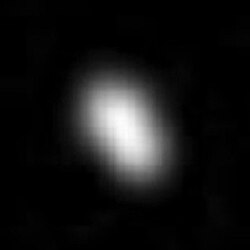Styx (moon)

Pluto's moon Styx, as seen by the New Horizons spacecraft on 13 July 2015, from a distance of 632,000 km
|
|
| Discovery | |
|---|---|
| Discovered by | Showalter, M. R. et al. |
| Discovery date |
|
| Photographic | |
| Designations | |
| Pronunciation | /ˈstɪks/ |
|
Named after
|
Styx |
| P5; S/2012 (134340) 1 | |
| Orbital characteristics | |
| 42656±78 km | |
| Eccentricity | 0.005787±0.001144 |
| 20.16155±0.00027 d | |
| Inclination | 0.809°±0.162° |
| Satellite of | Pluto |
| Physical characteristics | |
| Dimensions | ≈ 16 × 9 × 8 km |
| Mass | 7.5×1015 kg |
|
Sidereal rotation period
|
3.24 ± 0.07 d (chaotic) |
| 82° (to orbital plane) | |
| Albedo | 0.65 ± 0.07 geometric |
| 27±0.3 | |
Styx is a small natural satellite of Pluto whose discovery was announced on 11 July 2012. It was imaged along with Pluto and Pluto's other moons by the New Horizons spacecraft in July 2015. A single image was returned.
Styx is the second satellite of Pluto by distance and the fifth discovered. It was discovered one year after Kerberos. Styx is approximately 13 × 8 km across, and its orbital period is 20.2 days.
Styx was discovered by a team led by astronomer Mark R. Showalter, using fourteen sets of images taken between 26 June and 9 July 2012 by the Wide Field Camera 3 fitted to the Hubble Space Telescope. The discovery was announced on 11 July 2012. Styx is about half as bright as the dimmest previously known object in the system, Kerberos, and about one hundred thousandth as bright as Pluto. It was designated S/2012 (134340) 1, and informally referred to as P5.
The survey work leading to the discovery of Styx was in preparation for the mission of the unmanned New Horizons spaceprobe, which flew by the Pluto system on 14 July 2015. The discovery of another small Plutonian moon heightened concerns that this region of space may harbor more bodies too small to be detected, and that the probe could be damaged by an uncharted body or ring as it traversed the system at a speed of over 13 km/s; tiny moons, such as Saturn's moon Pallene, tend to be associated with tenuous rings or arcs, because their gravity is unable to hold on to material ejected by meteoroid impacts; such diffuse material represents the chief navigational hazard. However, the New Horizons probe did not detect any smaller moons or rings, and passed through the Pluto system safely.
The unexpectedly complex moon system around Pluto may be the result of a collision between Pluto and another sizable Kuiper belt object in the distant past. Pluto's moons may have coalesced from the debris from such an event, similar to the early giant impact thought to have created the Moon. The orbital resonances may have acted as "ruts" to gather material from the smashup.
...
Wikipedia
